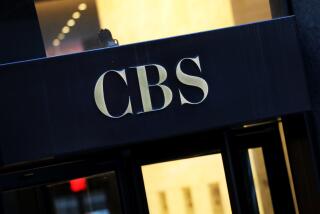Now playing: A glut of ads
As head of production at New Line Cinema, Toby Emmerich is not your typical moviegoer. So when he wanted to see “War of the Worlds” the other night, his choice was between seeing the film in a theater with a tub of popcorn or watching it in a screening room at Jim Carrey’s house, with a private chef handling the culinary options. Despite this seemingly loaded deck, Emmerich opted for a real theater.
“I love seeing a movie with a big crowd,” he says. “But I had no idea how many obnoxious ads I’d have to endure -- it really drove me crazy. After sitting through about 15 minutes of ads, I turned to my wife and said, ‘Maybe we should’ve gone to Jim Carrey’s house after all.’ ”
When DreamWorks marketing chief Terry Press took her young twins to see “Robots” this year, she said, “My own children turned to me and said, ‘Mommy, there are too many commercials!’ Now, when the lights go halfway down, I’m filled with dread. The whole uniqueness of the moviegoing experience is being eroded by all the endless ads.”
You don’t have to be an industry insider to be aggravated. Ads are one of the reasons why moviegoers, especially adults, are abandoning theaters this summer. When my favorite music biz blogger, Bob Lefsetz, wrote recently about being bombarded with ads before seeing “Crash” at a local theater, he was deluged with supportive mail from incensed ad-loathing readers. As Barry Ritholtz put it: “The commercials just add insult to an already declining experience.”
It’s only going to get worse. According to the Cinema Advertising Council, ads in theaters increased by 23% last year alone. The New York Times recently reported that Gillette aired its first in-theater ad, touting its new Pulsar toothbrush, convinced that a big-screen look at the toothbrush’s new technology will “have amazing visual impact.”
I can testify to the impact, though I’d call it more depressing than amazing. I saw the ad last week during an afternoon of theater ad watching. The Pulsar ad was just one of roughly two dozen ads, public-service spots and behind-the-scenes film and TV features that make up the 2wenty, a 20-minute package of ads that plays on 5,700 screens in Regal theaters around the country. Put together by National CineMedia, a joint venture between the Regal and AMC theater chains, the 2wenty represents, depending on your point of view, a new high or low in theater advertising.
Cliff Marks, National CineMedia’s president of sales and chief marketing officer, says he isn’t presenting commercials but “an entertaining content piece” in which nearly half the ads are created for or seen first in theaters. He’s recruited four Big Media partners -- Universal Studios, Sony Pictures Entertainment, NBC and TBS -- that produce behind-the-scenes features for the package. He insists moviegoers have no problems with well-presented ads. “Our research shows that the overwhelming majority of people like the 2wenty,” he says. “Most importantly, we end our show at the designated show time -- we’re doing it on our time, not on your time.”
No one will say how much theater owners are making from ads, but it seems clear that annual revenues are sizable -- CineMedia’s media partners alone are paying millions for their chunk of the Regal package. If I viewed it simply as an investor, I’d be impressed, especially by the shrewd foresight of real estate magnate Phil Anschutz, who has emerged as America’s largest theater owner, combining his Regal chain with United Artists and Edwards Theaters.
Buying into the business when many chains were in bankruptcy, the reclusive billionaire has poured roughly $70 million into equipping Regal theaters with new digital video technology. But that technology isn’t being used to show “War of the Worlds” on a hi-def digital video system. Theater owners are content to wait for the studios to pony up most of the conversion costs for digital projection. Anschutz put all that money into the theaters largely to sell more ads. The $70-million investment, which includes satellite delivery capability, allows Regal, via CineMedia, to play a new package of advertising each month, with custom-crafted versions of the 2wenty to run in front of PG, PG-13 or R-rated movies.
My first look at the 2wenty came at the Grand Palace theater in Calabasas, a sleek replica of a 1940s movie house that has a six-screen multiplex. The package is a big step up from the hodgepodge of slides and spots airing in most theaters. There were even two clever ads: a Nike “Friday Night Lights”-style look at high school football and a making-of feature on “The 40-Year-Old Virgin,” a Universal comedy starring Steve Carell. Instead of just showing tedious interviews with the filmmakers, the feature cannily sold Carell himself, showing clips of him in “Bruce Almighty,” “The Office” and on “Late Night With Conan O’Brien.”
But the rest of the 2wenty was given over to routine spots you could see on TV; Fanta and Sony Ericsson ads I’d seen in other theaters I went to; a promo for a Regal MasterCard; an L.A. Times ad with bad techno music, and commercials for three TV shows, including NBC’s “The Biggest Loser.”
I’ve seen TV show ads in theaters before. But somehow the sheer absurdity of the idea didn’t really register until watching the “Loser” spot. Imagine being a studio executive sitting in a movie theater -- the once-sacred palace where we saw glorious dreams in the dark -- being exhorted to stay home next Tuesday night to watch “The Biggest Loser.” Wouldn’t you fear for your future?
The studios have only themselves to blame. As ads began to creep into theaters years ago, virtually everyone turned a blind eye. The only studio to take a stand was Disney. In 1990, the studio said it wouldn’t allow any ads in front of its films. The studio lifted the ban on Touchstone films a few years ago, but it still refuses to allow ads before its Disney-brand films. Says studio chief Dick Cook: “We felt theaters were the last bastion of a commercial-free environment and that ads simply weren’t appropriate, especially in front of films playing to kids and families.”
There are a few small theater chains that refuse ads. The Pacific theater chain’s ArcLight Cinemas in Hollywood is commercial free, charging moviegoers $14 in return for a more pristine environment. Jerry Pokorski, the chain’s head film buyer, says ArcLight’s strategy is a big success, but he’s vague about how soon Pacific will extend its no-commercial policy to other theaters. “It’s where we’re going in the future, but we’re still trying to understand the economics of the whole thing.”
For the studios, the economics are simple. They’re conglomerates now, meaning that advertising a cellphone in a theater may help Sony’s bottom line as much as the profits from a new film. Even if an NBC ad sours a few people on seeing a Universal film, it evens out in the end. Still, it’s not hard to connect the dots between the growth of in-theater advertising and the continuing box-office slump. At a time when virtually every technological innovation, from TiVo to the iPod to satellite radio, is geared to helping us escape advertising, movie theaters are subjecting us to more of it.
The studio marketers say they’re caught between a rock and a hard place. As more consumers tune out commercial TV and radio, marketers have to grab eyeballs where they find them. “I’m just trying to keep our business alive,” says Geoff Ammer, president of Sony worldwide marketing. “We get information every week about how many new [digital video recorders] there are. Three years ago, it was 750,000 homes. Now it’s roughly 3 million. The day when it’s 50 million homes is not far away.”
Universal Pictures Vice Chairman Marc Shmuger insists that Universal’s making-of features for CineMedia respect moviegoer sensibilities. “We find that people have enjoyed them,” he says. “As a marketer, our challenge is to make a connection with people. If we can’t find the consumer as easily on TV, then we have to go to the one place where you know the moviegoer is -- in the theater.”
The problem is that people who advertise in theaters -- especially movie studios -- have made a devil’s bargain. The more polished the ads, the more they dilute the potency of the ads we actually enjoy -- the coming attractions. We need someone who loves movies to take a stand.
If Steven Spielberg had decreed that he’d play “War of the Worlds” only in theaters that didn’t run ads, the commercials would’ve vanished. George Lucas reportedly forced theaters to limit the amount of trailers before “Revenge of the Sith.” If only he’d gone after the real villains -- the ad-mongers -- he would’ve been viewed as a hero.
If someone doesn’t step up to the plate soon, movie theaters will soon find themselves in a one-quadrant business, catering to restless teenagers. The rest of us will happily watch DVDs on our giant plasma TVs, no longer able to remember the last time we felt the need to make that woeful trek to a multiplex that looks more like an ad-plastered NASCAR track with every passing day.
The Big Picture appears Tuesdays in Calendar. Comments or suggestions can be e-mailed to patrick.goldstein@latimes.com.
More to Read
The biggest entertainment stories
Get our big stories about Hollywood, film, television, music, arts, culture and more right in your inbox as soon as they publish.
You may occasionally receive promotional content from the Los Angeles Times.










